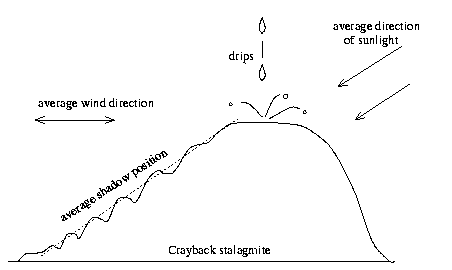Cave Entrances - Crayback Effects on Stalagmites
This article is concerned with the effect of air movement and light in cave entrances to produce an unusually symmetrical and crenulated stalagmite deposit known as a crayback. The term crayback is derived from the fancied resemblance of the speleothem to the segmented backs and tails of crayfish. Other names include phototropic stalagmites and stromatolitic stalagmites.
Craybacks occur in cave entrance zones wherever there is light, some air movement and a drip point. In the absence of light, an oval section stalagmite would be produced. This is discussed in Oval section stalagmites.
Craybacks are similar to oval section stalagmites however superimposed on the overall oval cross section is a crenulation which is oriented towards the average source of daylight. They are generally a green colour from cyanobacteria. I have seen a white crayback in Fig Tree Cave, Wombeyan Caves, however it was not far from daylight and possibly it was still under the influence of dimly reflected light.
| Cross section view of crayback stalagmite |
|---|

|
How the shape is attained
- The overall elongated shape is due to air moving the drips back and forth as the air moves in or out of the cave entrance. The higher the roof, the longer the stalagmite tends to be.
- The tendency to deposit more calcite at the sunny side compared to the darker shaded side is due to the photosynthetic cyanobacteria on the stalagmite surface absorbing CO2 at a higher rate on the sunny side than it can on the shaded side. Calcite tends to precipitate if the dissolved CO2 in the drip water is removed (in this case, by phptosynthesis in the cyanobacteria as well as the agitation caused by splashing). At night, deposition would be governed by physics only (like oval section stalagmites) whereas by day, deposition would be influenced by the photosynthetic effect as well.
- The small crenulations on the shaded side of the stalagmite are also due to photosynthetic cyanobacteria. Over time, the higher points tend to be deposited faster, which shades the lower points on the surface even more. The shape of the crenulations mimics that of the overall stalagmite, with the sunny side tending to be steeper than the darker side. This should not be confused with the crenulations on the sides of dark zone stalagmites, which are due to a physics property. The shapes of the crayback crenulations are different.
A typical crayback can be from 0.5 to 3 metres high with crenulations about 10 cm high.
Excellent examples of large craybacks can be seen on the self-guided tour of Victoria Arch, Wombeyan Caves NSW. A sectioned crayback is on display at Jenolan Caves, NSW. It was from Nettle Cave, Jenolan.
| In caves with more than one entrance you may see what appear to be double ended craybacks or simply greenish stalagmites with an elongated appearance and a crenulated top. These are usually associated with caves with two entrances, ie the light can come from two sides, and the roof may not be high enough to develop the long "tail" on the stalagmite. | 
|
They should not be confused with vertical cave shields which have an entirely different origin.
Also along their sides you may see small columns of soil with a pebble on top. This is an erosional feature most likely caused by excess drips washing away the soil next to the stalagmite except where small pebbles protect the silt pillar. These are the start of another speleothem, coral pipes. Eventually they would be coated with calcite, become true coral pipes for a while, then they would coalesce and form a wider stalagmite.
Here are some pictures of craybacks. They can also be seen in a photo of part of Abercrombie Arch.
Further information on craybacks and stromatolitic stalagmites can be found in Hill & Forti, and also James, Patsalides and Cox (1) and (2).
Deflected Stalactites
Light can affect the growth of stalactites, too, making them appear to lean towards the light.
Again the effect of photosynthesis by cyanobacteria and algae is to absorb CO2 from the moisture
on the light side of the stalactite more than the dark side.
This tends to deposit more calcite on one side, leading to a deflected stalactite.
See also Wind Effects - deflected stalactites.
Similar effects can be observed in dripstone fringes resulting in a variety of fanciful forms, much
photographed by tourists.
The effect of light on Travertines
As travertines are usually fairly evenly illuminated in cave entrances, the main effect is not so much an alteration of the shape of the travertine as a diurnal variation in the size and shape of calcite crystals deposited.An article by Folk, Chafetz & Tiezzi describes the type of calcite deposited in travertines although their samples were not spelean.
References
1. James, J.M., Patsalides, E., and Cox, G., 1994a, Amino acid composition of stromatolitic stalagmites: Geomicrobiol. Jour., no. 12, p.183-194.2. James, J.M., Patsalides, E., and Cox, G., 1994b, Amino acids - a fingerprint for cyanobacteria in stromatolitic speleothems (abs.): in Sasowsky, I.D., and Palmer, M.V. (eds), Breakthroughs in karst geomicrobiology and redox geochemistry, abs. and field-trip guide, Colorado Springs, Co., Feb. 16-19, Karst Waters Inst. Spec. Pub No. 1, p 30-31.
3. Folk, Robert L., Chafetz, Henry S., & Tiezzi, Pamela A. 1985. Bizarre Forms of Depositional and Diagenetic Calcite in Hot-spring travertines, Central Italy. In: Carbonate Cements, special publication No. 36, The Soc. Econ. Paleontologists & Mineralogists, a div. of the American Assoc. of Petroleum Geologists.
Cosmetic update, September 2025. Content created 29th July 2001 and updated 30th January 2006.